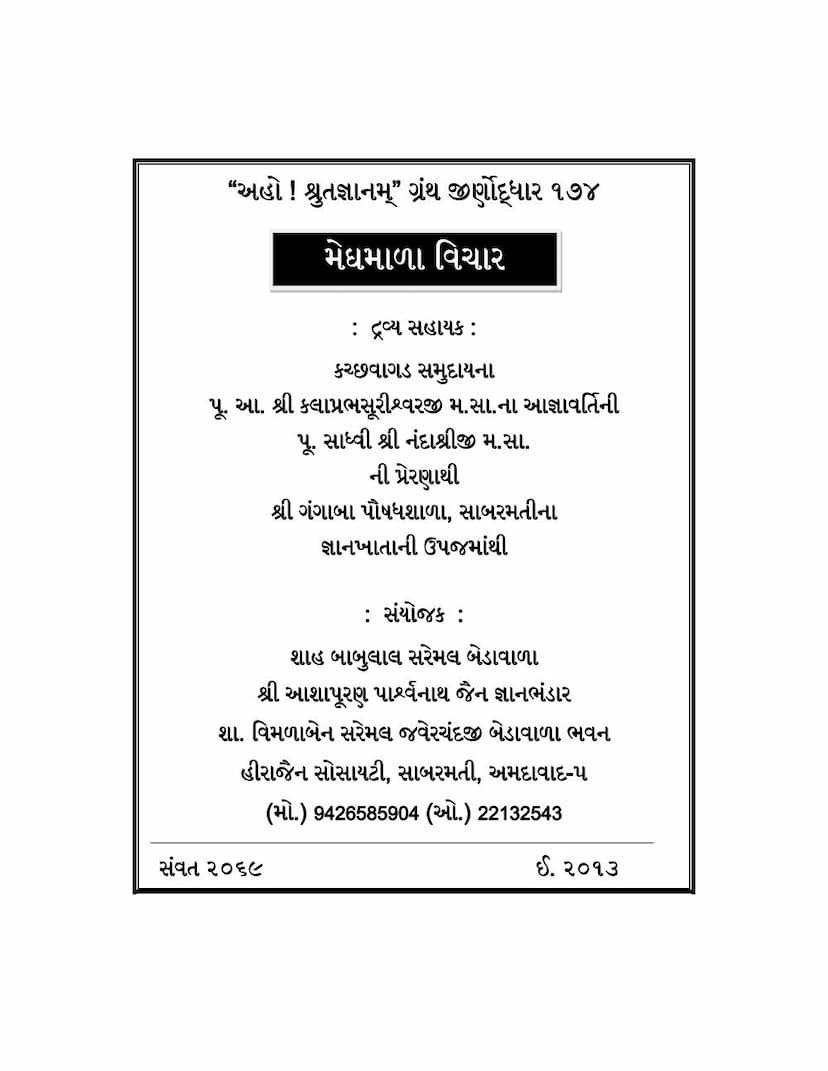Meghmala Vichar
Added to library: September 2, 2025

Summary
Here's a comprehensive summary of the provided Jain text, "Meghmala Vichar," authored by Vijayprabhsuri, published by Meghji Hirji, based on the catalog link and the pages provided:
Book Title: Meghmala Vichar (મેઘમાળા વિચાર) Author: Acharya Vijayprabhsuri (આચાર્ય વિજયપ્રભસૂરિ) Publisher: Meghji Hirji Jain Booksellers, Mumbai (મેઘજી હીરજી જૈન બુકસેલર્સ, મુંબઈ)
Overall Purpose and Content:
"Meghmala Vichar" is a Jain text authored by Acharya Vijayprabhsuri that focuses on the study of weather patterns, particularly rainfall, and their omens and predictions. The book delves into the relationship between celestial bodies, astrological influences, natural phenomena, and the anticipated outcomes for agriculture and human well-being. It appears to be part of a larger collection of Jain scriptures, as indicated by the catalog links and the repeated mention of "Aho! Shrutgyanam Granth Jirnoddhar" (અહો ! શ્રુતજ્ઞાન ગ્રંથ જીર્ણોદ્ધાર), suggesting a project to preserve and make accessible ancient Jain texts.
The text is structured as a detailed almanac or predictive guide, offering insights into the auspiciousness and potential outcomes of various celestial and atmospheric events associated with specific months and days. It aims to provide guidance for farmers, merchants, and the general populace to understand and prepare for the coming seasons.
Key Themes and Topics Covered:
-
Meteorological Predictions: The core of the book is dedicated to predicting rainfall and its impact. It meticulously analyzes the influence of:
- Lunar and Solar Days: The position of the moon and sun on specific days and lunar phases.
- Nakshatras (Lunar Mansions): The role of various nakshatras in influencing weather.
- Planetary Positions: The conjunctions and influences of planets.
- Day of the Week: The significance of specific weekdays when certain celestial events occur.
- Directional Influences: The impact of winds and celestial phenomena from different directions (East, West, North, South, etc.).
- Natural Omens: Observations of clouds, lightning, thunder, rainbows, halos around the sun and moon, falling stars, and even the behavior of birds like crows.
-
Seasonal Analysis: The book provides month-by-month analysis, starting from Kartika (Kartik) and progressing through the lunar calendar (Margashirsha, Pausha, Magha, Phalguna, Chaitra, Vaishakha, Jyeshtha, Ashadha, Shravana, Bhadrapada, Ashvina). For each month, it details specific signs and their predicted outcomes.
-
Impact on Agriculture and Society: The predictions are linked to:
- Crop Yields: The abundance or scarcity of grains, pulses, and other agricultural produce.
- Prices of Commodities: Fluctuations in the prices of grains, oil, and other goods.
- Natural Calamities: Warnings of drought, excessive rain (floods), epidemics, famine, and even war or political instability.
- Animal Husbandry: The impact on cattle and other livestock.
- Human Well-being: Predictions regarding health, prosperity, and general welfare of the populace.
-
Astrological and Astronomical Underpinnings: The text relies on ancient Jain astrological and astronomical knowledge, associating weather patterns with the movements and configurations of celestial bodies. It refers to concepts like "Jyotish" (astrology/astronomy) and specific astrological texts.
-
Supplement from Rudrayamala Tantra: A significant portion of the book, particularly towards the end, includes a supplement from the Rudrayamala Tantra. This section elaborates on the relationship between clouds, lightning, and wind, and their predictive significance. It also includes observations on the behavior of crows in specific directions from trees as omens.
-
Guidance for Action: The book implicitly or explicitly advises readers on how to prepare for the predicted conditions, such as storing grains, taking precautions against epidemics, or understanding market fluctuations.
-
Preservation Project: The accompanying catalog information highlights the "Aho! Shrutgyanam Granth Jirnoddhar" project, indicating that this digitized version is part of an effort to restore and make accessible rare and ancient Jain manuscripts, preserving valuable traditional knowledge.
Structure and Tone:
The text is written in a scholarly yet practical tone, blending astronomical knowledge with societal concerns. It uses a verse-like structure in many sections, characteristic of classical Indian texts, making the predictions memorable and easily transmissible. The inclusion of Sanskrit verses and their Gujarati translations demonstrates an effort to make the content accessible to a wider audience.
Significance:
"Meghmala Vichar" offers a glimpse into the traditional Jain approach to understanding and predicting weather patterns, deeply intertwined with their philosophical and astrological worldview. It highlights the importance placed on such knowledge for the well-being of the community, particularly in an agrarian society. The preservation of this text through digitization underscores its historical and cultural value.
In essence, "Meghmala Vichar" is a comprehensive Jain treatise on weather forecasting, drawing from astrological principles and observational data to provide guidance on agricultural prosperity, public health, and societal stability throughout the year.